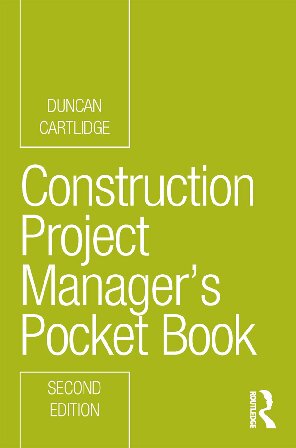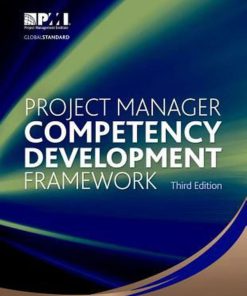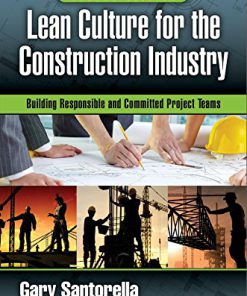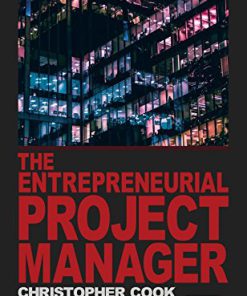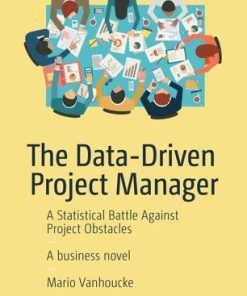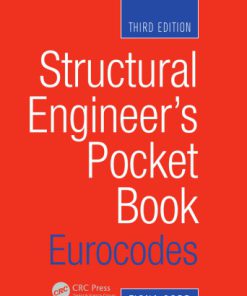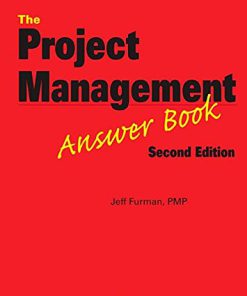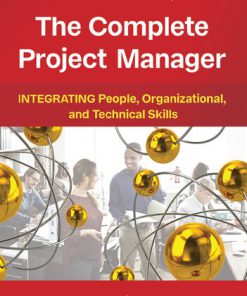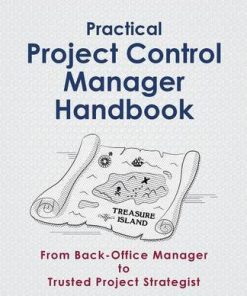Construction Project Manager Pocket Book Routledge Pocket Books 2nd Edition by Duncan Cartlidge ISBN 1000034046 9781000034042
$50.00 Original price was: $50.00.$25.00Current price is: $25.00.
Construction Project Manager Pocket Book Routledge Pocket Books 2nd Edition by Duncan Cartlidge – Ebook PDF Instant Download/Delivery: 1000034046, 9781000034042
Full download Construction Project Manager Pocket Book Routledge Pocket Books 2nd Edition after payment
Product details:
ISBN 10: 1000034046
ISBN 13: 9781000034042
Author: Duncan Cartlidge
The second edition of the Construction Project Manager’s Pocket Book maintains its coverage of a broad range of project management skills, from technical expertise to leadership, negotiation, team building and communication. However, this new edition has been updated to include:
- revisions to the CDM regulations,
- changes to the standard forms of contract and other documentation used by the project manager,
- the impact of BIM and emerging technologies,
- implications of Brexit on EU public procurement,
- other new procurement trends, and
- ethics and the project manager.
Construction project management activities are tackled in the order they occur on real projects, with reference made to the RIBA Plan of Work throughout. This is the ideal concise reference which no project manager, construction manager, architect or quantity surveyor should be without.
Construction Project Manager Pocket Book Routledge Pocket Books 2nd Table of contents:
1 Project management – an overview
What is a project?
What is project management?
Development of modern project management
Frederick Taylor
Henry Gantt
William Edwards Deming
Modern project management timeline
1950–1959
1960–1979
1980–1994
1995–present
Project management governance and professional bodies
Association for Project Management (APM) www.apm.org.uk
Project Management Institute (PMI) www.pmi.org/uk
The Royal Institution of Chartered Surveyors (RICS) www.rics.org
The Chartered Institute of Building (CIOB) www.ciob.org
Concepts of ethics
Where do ethics come from?
Ethics and the project manager
Why is ethics important for project managers?
Ethics and the law
Unethical behaviours, activities and policies
Ethics – the business case
Ethical decision-making models
Defining the role
Constraint – scope
Constraint – cost
Constraint – time
Constraint – quality
Constraint – risk
Generic / soft project management skills
Leadership
Autocratic leadership
Participative leadership
Delegative leadership
The correct approach
Motivation
Classifying needs
Communication
Types of communication
Running a productive meeting
Conversation
Avoid ambiguity
Have a purpose
Assertiveness
Confrontations
Seeking information
Letting others speak
To finish
Budgetary control
Change management
Change management models
Lewin’s Change Management Model
McKinsey 7-S Model
Kotter’s 8 Step Change Model
Organisational development
Business process re-engineering
Project management tools and techniques
PRINCE2
Benefits of using PRINCE2
PRIME
Microsoft Project
Newforma
Project management phases
1. Initiating the project
SWOT analysis
PESTLE or PEST analysis
2. Planning / organisation
Developing a project plan
3. Executing / implementation
4. Monitoring and controlling
5. Closing / evaluation
The construction project manager
Deciding on the project team structure
The role of the project manager and JCT (16)
The role of the project manager and NEC4
Flexibility
Clarity and simplicity
The construction project manager and digital construction
Building Information Modelling (BIM)
Cloud-based software applications
Robots and drones on-site
3D printing
Artificial intelligence (AI)
Blockchain technology
Managing multiple projects
2 Pre-construction / RIBA Plan of Work Stages 0–4 / OGC Gateway Stages 1–3C
Early stages
RIBA Plan of Work (2013)
Task bar 8: BIM Information Exchanges
Choice of project team members
Roles of project team members
Client or project sponsor
Project manager
Architect / lead designer
Contract administrator
Information manager
BIM manager / co-ordinator
Cost consultant / quantity surveyor
Structural engineer
Civil engineer
Construction manager
Main contractor / subcontractors / suppliers
Environmental health officer
Building control / warrant officer
Local planning authorities (LPAs)
Fire safety inspector
The police
Preparation
Strategic Definition / Preparation (RIBA Stages 0 & 1)
Terms of engagement / appointment
BSRIA Soft Landings and Government Soft Landings (GSL)
Professional indemnity insurance for project managers
Preparation / briefing
The business case
The strategic brief
Feasibility studies / business case development
IT / software packages / BIM
Sustainability / green issues
BREEAM
LEED
EcoHomes points / Code for Sustainable Homes
Value engineering / management
Design
Design management / specialist design / BIM
Lead consultant
Design co-ordination at each stage of the RIBA Plan of Work (BIM outputs)
Stages 0 & 1 Strategic Definition and Preparation and Brief
Data Drop 1: Model represents requirements and constraints
Stage 2 Concept Design
Stage 3 Design Development
Data Drop 2: Model represents outline solution
Stage 4 Technical Design
Data Drop 3: Model represents construction information
Stage 5 Construction
Data Drop 4: Model represents operations and maintenance information
Stages 6 & 7 Handover and Close Out
Data Drop 5 (and subsequent drops): Model represents post-occupancy validation information and ongoing o&m
Design changes
Contractor involvement in the design process
Contractor designed portions
Planning permission
Enterprise Zones
Role of project manager in planning
Building Regulations
Party wall issues
Rights of light
Disability legislation
Health and safety in construction
Construction (Design and Management) (CDM) Regulations 2015
Construction Phase Plan
Health and Safety Plan
Dangerous substances
Asbestos
Cost advice / whole life costs
Criticisms of whole life costing
Whole life cost procurement – critical success factors
RICS NRM 3 – order of cost estimating and cost planning for building maintenance works
Risk
Who carries the risk?
Risk accountability
How to deal with risk
Risk attitude
Risk management
Risk identification
Risk assessment
Qualitative assessment
Quantitative assessment
Risk monitoring and control
Risk response
Risk avoidance
Risk reduction
Risk transfer
Risk retention
Risk and procurement strategies
Tools and techniques of risk identification
Ishikawa diagram
Risk register
Decision trees
Software packages
Qualitative risk analysis
Sensitivity analysis
Cost–benefit analysis (CBA)
Procurement strategies
Negotiation
Competition
Procurement routes
Single-stage selective tendering
Two-stage competitive tendering
Design and build (D&B) and variants
Traditional design and build
Management procurement
Management contracting
Construction or contract management
Design and manage
Cost reimbursement contracts
Cost-plus contracts
Contractor designed portion
Pre-qualification questionnaires
Target cost
Term contracts / schedule of rates
Negotiated contracts
Partnering / frameworks
Partnering
Alliancing
Prime contracting
Frameworks
New models of construction procurement
EU public procurement / environmental impact assessment
EU public procurement and Brexit
European public procurement law
The Directives – theory and practice
The EU procurement procedure
Award procedures
Competitive procedure with negotiation
Innovative partnerships
Concessions
Electronic tendering
Electronic auctions
Technical specifications
Public procurement beyond Europe
Environmental impact assessment (EIA)
About the EIA Directive
Public–private partnerships (PPPs)
Sustainable procurement
Procurement paths and risk
Single-stage
Design and build
Management contracting
Cost advice
Gross external area (GEA)
Gross internal floor area (GIFA)
Net internal area (NIA)
The RICS New Rules of Measurement 1: Order of Cost Estimate and Cost Planning for Capital Building Works
RICS New Rules of Measurement – order of cost estimate format
Initial risk register: Risk allowance estimate
3 Construction / RIBA Plan of Work Stage 5
Roles for the project team
Client
Architect
Clerk of works
Structural engineer
Quantity surveyor
Main contractor’s team
Project quality management
Quality audit
Off-site construction and modern methods of construction
Environmental management systems (EMS)
What is an environment management system?
Works on-site
Meetings
Site meetings
Project meetings
Initial meeting
Ongoing meetings
General review meetings
Ten rules for running productive meetings
Construction
Cost control / financial reporting
Financial statements
Interim payments
Cash flow forecasting
Variations and change orders
Payments to the supply chain
Payment Notices
Withholding Notices
Default Notices
Payee-led payment process
Suspension of performance
Adjudication
In conclusion
Cash flow
Acceleration
How can acceleration be achieved?
NEC4
Insolvency / bankruptcy / sequestration
Suspension of payment
Stage payments / cash flow projections
Supply chain relationships and management
What is a supply chain?
Insurances – injury, damages and insurance
Injury to persons and property
Insurance of the works
Contractor-designed portion professional indemnity insurance
Joint Code of Practice: Fire prevention on construction sites (Ninth Edition)
Bonds
Guarantees – collateral warranties
Collateral contracts
Collateral warranties between employer and subcontractor
4 Post-construction / OGC Gateway 4–5 / RIBA Plan of Work Stage 6
Post-construction
What happens at practical completion?
What does completion mean?
Sectional completion
Partial completion
Latent and patent defects
Taking possession
To note
Facilities / data migration
Handover and operation
Handover schedule
Post-project review
End of contract report
Facilities management
Use and aftercare – Soft Landings / Government Soft Landings
Stage 1 – Inception and briefing
Stage 2 – Design development and review
Stage 3 – Pre-handover
Stage 4 – Initial aftercare
Stage 5 – Extended aftercare and post-occupancy evaluation
Commissioning
Testing or commissioning?
Testing
Commissioning
Performance testing
Client commissioning
Operation and maintenance
COBie
Alignment of NRM 3 to COBie II data structure and definitions for Building Information Modelling
PAS (Publicly Available Specifications) 1192–3
Performance measurement
Benchmarking facilities
Performance measurement
5 Occupancy / RIBA Plan of Work Stage 7
Project audit
Stage 1 – establishment of success criteria and questionnaire development
Success criteria
Questionnaire development
Project audit questions
Questionnaires
Stage 2 – background research
Stage 3 – report development
Conclusion
Post-occupancy evaluation (POE)
A suggested approach
Methodologies
Questionnaires
Interviews
Focus groups
Visual surveys
Energy use surveys (assessments)
Building walk-throughs
Feedback
Short-term benefits
Medium-term benefits
Longer-term benefits
The Usable Buildings Trust
Appendix A Financial statement
Appendix B Practical completion certificate pro-forma for NEC4 form of contract
Appendix C Final account pro-forma
Appendix D Design / construction project sample risk list
Appendix E Sample questionnaire format
Further reading
Glossary
Index
People also search for Construction Project Manager Pocket Book Routledge Pocket Books 2nd:
construction project manager s pocket book
construction project manager’s pocket book
construction project manager’s pocket book pdf
construction project manager’s pocket book by duncan cartlidge
construction project manager’s pocket book routledge pocket books
Tags:
Duncan CartlidgemConstruction,Project Manager,Pocket,Routledge
You may also like…
Business & Economics - Project Management
Project Manager Competency Development Framework Project Management Institute
Business & Economics - Industries
Business & Economics - Project Management
Business & Economics
Business & Economics
Engineering Arts - Architecture
Structural Engineer s Pocket Book Eurocodes 3rd Edition by Fiona Cobb ISBN 9781466552081 1466552085
Business & Economics - Management & Leadership
Business & Economics - Management & Leadership
Business & Economics


